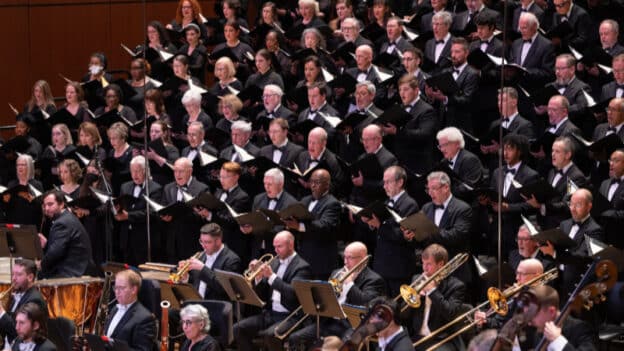Exclusive: What top orchestral execs are earning
NewsIt’s the time of year when consultant Drew McManus goes through the latest corporate tax accounts to find out what US orchestras are paying their presidents, chief executives and music directors. Drew’s list is published first on slippedisc.com.
Here’s the rundown for the tax year ending July 2019, the kast one before Covid. What it reveals is that Deborah Borda, who was the highest paid orchestral executive at the Los Angeles Philharmonic has not lost one penny by moving to the New York Phil; that Mark Volpe at Boston (now retired) was the only other million-dollar orchestra manager; and that Chicago should be offering its underpaid boss danger money.
Here’s the top ten.
New York Philharmonic: $1,455,594
Boston Symphony: $1,040,949
San Francisco Symphony: $968,107
Cleveland Orchestra: $952,523
Los Angeles Philharmonic: $897,508
Chicago Symphony: $564,516
National Symphony: $475,846
Detroit Symphony: $467,857
Dallas Symphony: $457,138
Pittsburgh Symphony: $437,343
Two further observations. Borda’s salary is almost exactly exquivalent to Peter Gelb’s at the Met. And these salaries are 3-4 times higher than their equivalent at the top European orchestras, where the players also earn less than their US counterparts.
Here’s Drew’s full list, covering the complete US orchesral waterfront.
Tomorrow: What music directors are being paid.






I actually work in the field of executive reward so I’m not scared of big numbers. But considering that many of these bodies are significantly dependent on donor funding or legacy endowments rather than pure revenue from ticket sales these numbers appear pretty high to me…
I don’t see what’s wrong with these organizations being dependent on donations and endowment revenue. Most nonprofit organizations don’t have sales revenue, and executive compensation largely takes into account fundraising.
Where I see these salaries being high is comparing them to the rest of the nonprofit sector. There are advocacy and social welfare organizations with budgets of up to $500 million (some in the billions), where the CEOs are objectively running much more complex organizations, and the salaries tend to be about half of these. For example, the CEO of the Dana-Farber Cancer Institute is paid $1.7 million; its budget is nearly $1.9 BILLION and it has 6,500 employees. That CEO is likely looking at what the NY Phil salary and thinking “WTF?”
As I say in all of these threads, the date ranges in 990s are not what you think they are.
The financial data in a 990 is reported on an organization’s fiscal year. Not every orchestra has the same fiscal year — none of this is apples to apples. And there is no such thing as “tax year ending July 2019.”
Looking at Boston’s 990, its fiscal year begins on September 1, so the most recent 990 covers 9/1/18 to 8/31/19.
The section on highest compensated employees is reported on the calendar year because the IRS wants that data to match the W2s submitted to it.
Here’s where things get complicated: You report the most recent fully completed calendar year salaries vis-à-vis the fiscal year. So in the case of Boston, and likely most of these 990s, the salary information is for calendar year 2018. So yeah, this data is really old.
Some other commentary:
I see that Drew reports total organization expenditures to provide some context for deciding whether salaries are justified or not; there’s other data worth taking into consideration, such as the number employees. I noticed that the NY Phil only has 750 employees while LA Phil has 2,696. I assume that’s because LA Phil has to manage all of its venues and it employees, such as the ushers, stagehands, and other performance support staff; with NY Phil, the concert hall at Lincoln Center is managed by Lincoln Center, and I imagine some or all of the ushers, stagehands, etc. are also employed by them. So the scope of work under orchestra executives even at the largest orchestras can be quite variable.
Excellent points!
A few other points:
When you dig into the “program service revenue,” you begin to get hints about much the organizations differ. For example, it’s clear that the LA Phil is operating its concert halls — they’re collecting revenue from other concerts, box office fees, concessions, and parking (bravo for them having major income sources outside of donations and their own ticket revenue.) That also looks to be the same case in Boston.
But this is also the limitation of using a 990 to determine if someone is properly paid — we only get hints at the scope of the responsibilities of the CEO.
Thanks, Monsoon – your points are excellent and accurate. The other thing to consider is that “total compensation” includes benefits. Given the exorbitant cost of health insurance in the US, that amount skews the numbers. And since the musicians of these orchestras receive only the finest coverage (i.e., most expensive), the staff receives the same – so that’s a big cost. Ditto with the expenses associated with a top-flight pension plan in order to match the musicians’ sweet deals.
“Chicago should be offering its underpaid boss danger money.”
1) Chicago is not “underpaid”, the others are overpaid.
2) “danger money” against … gun-shooting gangstas or Riccardo Muti?
Yeah, he got screwed during negotiations. Then again, he was coming from Toronto, hardly a bargaining leverage.
As for Muti, obviously, he’s going to be the highest paid maestro in America (ergo, the world).
What the CSO gained in the bargain with it’s President, it lost in its Music Director. It all comes out even with other orchestras at the end of the day.
When all will be said and done, the CSO will have lost more than that … like its dignity for instance.
My guess is … you have to read bewteen the lines.
You know how Trump WH staffers have a very hard time shopping their resume around.
What will the CSO president put on his resume? That he was Muti’s silent enabler, and that he extended the enablement until 2024?
If a rank and file CSO musician is making $150K and titled players more (sometimes much more), then I don’t think $550K is out of line for the CEO and the responsibility that entails.
The numbers may seem high to some but let’s remember that these CEOs are responsible for raising millions of dollars through ticket sales and contributions.
I’d rather see them paid 50% of what their salary is + 5% of what they raise over and above prior year……………..
Sorry but professional fundraisers never ever work on a commission or percentage basis. It is considered unethical.
Fact
I think it is time to set the record straight on CSOA President Jeff Alexander. He is, without question, one of the most skilled and successful orchestra managers in the country. Look at his superb record in Cincinnati where he worked for 16 years, 12 as General Manager (No. 2), and the remarkable accomplishments during his 14 years as President of the Vancouver Symphony Orchestra (not Toronto). In Chicago, where I know many of the musicians, board members, staff and volunteers, he is enormously appreciated for how he has run the organization for the past 6+ years. A quiet persona is so often mistaken as being weak. Imagine the spine of steel he has in dealing with Muti, surviving a 7-week strike, a 15-month pandemic, and how he has transformed the long-standing bitter, angry internal environment he inherited into one of peace, cooperation, mutual respect and support; all while being extremely gracious to everyone with whom he comes in contact. He is, in fact, a miracle worker.
Fair is fair and you are making a few solid points. Most reasonable people would agree that the President of the CSO has handled the pandemic-driven financial conundrum with great skill.
The “spine of steel” characterization is way off the mark. Rather, one could observe that Mr. Alexander is much more shrewd than many people realize. He has discovered the efficacy of a very clever and cheap appeasement – a diversion of sort – to keep Muti busy, occupied, and neutralized during non rehearsal hours.
What is the clever appeasement and what is the objective of neutralizing Muti? I learn something new every time I read through these comments. Thanks, Insider!